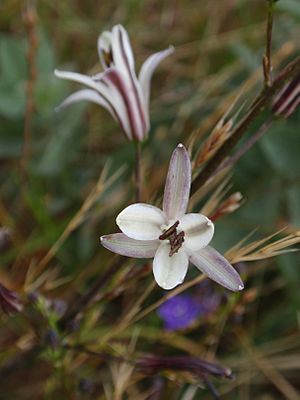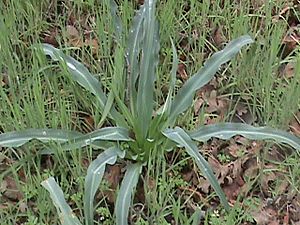Wavy-leafed soap plant facts for kids
Quick facts for kids Wavy-leafed soap plant |
|
|---|---|
 |
|
| Scientific classification |
The Chlorogalum pomeridianum, also known as the wavy-leafed soap plant, California soaproot, or Amole, is a common plant found in California. It belongs to a group of plants called soap plants, which are known for their special properties. Sometimes people call it "wild potato," but it's not related to potatoes at all.
This plant grows in many parts of California, from the coastlines to the western hills of the Sierra Nevada. You can also find it in the Klamath Mountains in southwestern Oregon. However, it does not grow in desert areas. The wavy-leafed soap plant likes to grow on rocky cliffs, in grasslands, in areas with chaparral shrubs, and in open woodlands.
Contents
What Does the Soap Plant Look Like?
Like all soap plants, Chlorogalum pomeridianum is a perennial plant. This means it lives for many years. It grows from a large, brown bulb that looks a bit like a big onion. This bulb is usually between 7 and 15 centimeters (about 3 to 6 inches) wide. It is covered in thick, rough fibers.
The leaves grow from the base of the plant. They can be quite long, from 20 to 70 centimeters (about 8 to 27 inches). They are also about 6 to 25 millimeters (about 0.2 to 1 inch) wide. As the name "wavy-leafed" suggests, their edges often have a wavy shape.
The plant's flowers grow on a long stem, which is usually taller than the leaves. Each flower is about 15 to 30 millimeters (about 0.6 to 1.2 inches) long. They have six petals, which are usually white. You might notice a purple or green line down the middle of each petal. The flowers also have six large, bright yellow or orange stamens. These flowers have both male and female parts.
A cool thing about these flowers is that they only open in the late afternoon or evening. They stay open all night but close by morning. Night-flying insects, like moths, help pollinate them.
Different Types of Soap Plants
There are a few different types, or varieties, of the wavy-leafed soap plant:
- Chlorogalum pomeridianum var. divaricatum: This type grows only in some coastal areas of California, usually below 100 meters (about 330 feet) in elevation.
- Chlorogalum pomeridianum var. minus: This type is found in parts of the Pacific Coast Ranges and the San Francisco Bay Area in California. Its bulb is not as fibrous as the other types.
- Chlorogalum pomeridianum var. pomeridianum: This is the most common type and can be found wherever the soap plant grows. In the Nomlaki language, it is called shlā.
How People Used the Soap Plant
The fibers around the plant's bulb were often tied together to make small brushes. People could also get a sticky liquid from the bulbs to use as a sealant or glue.
Used for Cleaning
The juices from the bulb contain natural chemicals called saponins. When these saponins mix with water, they create a foamy lather, just like soap! Because of this, Native American people, like the Miwok tribe, and early European settlers used the bulbs as a kind of soap. This is how the plant got its name. It was especially popular for washing hair because people believed it helped with dandruff.
Used for Food
The young leaves of the soap plant can be eaten. However, the bulbs contain saponins, which can be poisonous if eaten raw. Luckily, saponins are not easily absorbed by the human body and can be destroyed by thorough cooking. The Miwok people would roast the bulbs and eat them as a winter food.
In 1847, a man named Patrick Breen, who was part of the famous Donner Party (a group of pioneers who got stuck in the snow), wrote in his diary about eating some "roots resembling Onions." A Native American person gave them these roots. Breen said they tasted "some like a sweet potatoe, all full of little tough fibres." His son later called these roots "California soap-root," which was almost certainly the wavy-leafed soap plant.
Saponins are much more harmful to some animals than to humans. Fish are especially sensitive to them. So, people would sometimes use the bulb juices to stun or kill fish, making them easier to catch.
Used for Medicine
The bulbs also had different medicinal uses. People used them externally, meaning on the outside of the body. For example, they made a poultice (a soft, moist mass) from the bulbs to use as an antiseptic for wounds or to rub on sore spots for rheumatism. They also used the bulbs internally, meaning they drank liquids made from them. These liquids were used for various purposes, like helping the body get rid of extra water (as a diuretic), helping with digestion (as a laxative), and easing stomachaches.
See also
 In Spanish: Chlorogalum pomeridianum para niños
In Spanish: Chlorogalum pomeridianum para niños


